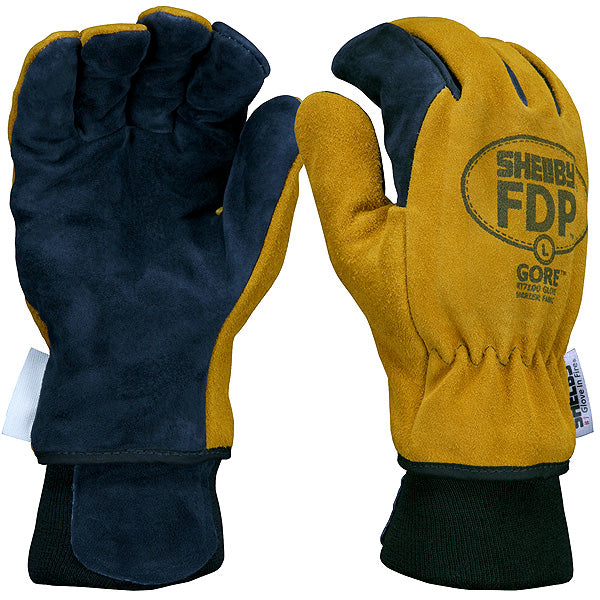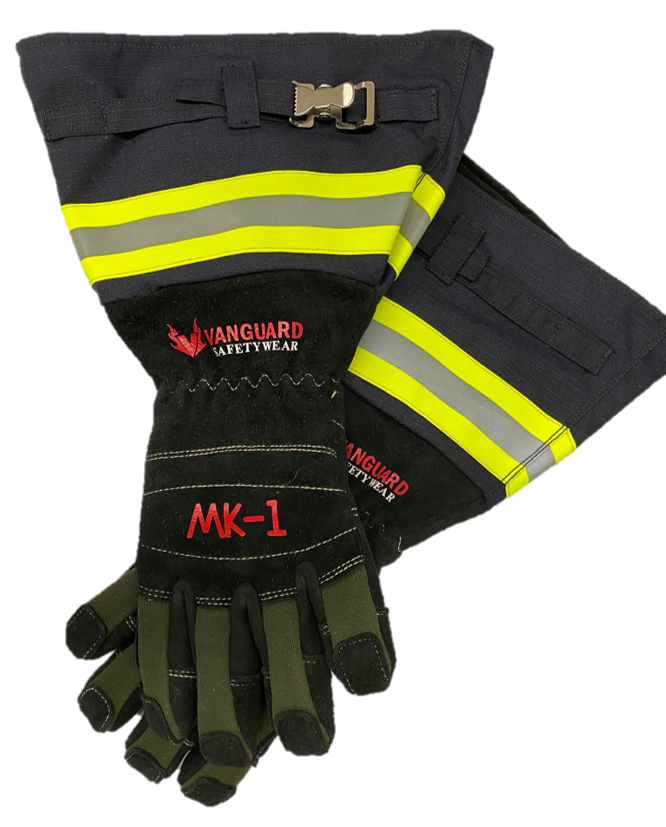Fire fighting gloves are essential safety gear for firefighters, designed to protect hands from heat, cuts, and chemicals. They are flame-resistant, durable, and enable agility during rescue operations.
Selecting the right fire fighting gloves is crucial for the safety and performance of firefighters. Made from materials that withstand extreme temperatures, such as Kevlar or Nomex, these gloves also often include a waterproof layer to protect against water and other liquids.
Grip is a top consideration, as firefighters need to maintain control of their equipment at all times. Comfort and fit are equally important, as ill-fitting gloves can impede flexibility and responsiveness. Manufacturers rigorously test fire fighting gloves to meet industry standards, ensuring they provide the highest degree of protection possible. Equipping firefighters with the proper gloves is an integral part of their protective ensemble, a fact recognized and emphasized by fire departments around the world. Well-designed fire fighting gloves can mean the difference between safety and injury, making their selection a top priority for fire safety personnel.
The Importance Of Proper Hand Protection
For firefighters, hands are vital tools in life-saving situations. Protecting them is crucial. Quality firefighting gloves not only preserve dexterity and comfort but also provide critical defence against a range of hazards. Let’s explore these risks and how gloves significantly reduce potential injuries.
Risks Faced By Firefighters’ Hands
Firefighters face intense thermal exposure, punctures, and harmful chemicals. Each call to action combines these risks, making their hands vulnerable to burns, cuts, and infections. The variety of dangers include:
- Extreme heat and flames
- Sharp debris and broken glass
- Exposure to toxic substances
- Electrical hazards
The Role Of Gloves In Injury Prevention
Gloves crafted for firefighting are more than basic hand coverings. They utilize advanced materials and design techniques to shield against the risks mentioned. Key glove features include:
- Heat-resistant fabrics that withstand high temperatures.
- Puncture-resistant layers that protect from sharp objects.
- Waterproof coatings that keep hands dry and prevent chemical penetration.
- Insulation to maintain hand warmth in cold environments.
- Flexibility to allow intricate movements and operation of equipment.
Gloves serve as a first line of defense, reducing injury risks and ensuring that firefighters remain capable of performing their duties effectively.

Credit: www.datrex.com
Materials And Technologies In Fire Fighting Gloves
Fire fighting gloves stand as a critical barrier between firefighters and the extreme conditions they face. Materials and technologies in these gloves play a pivotal role in their performance. Advances in materials science have led to significant improvements, assuring durability and protection in the fiercest of blazes.
Heat-resistant Fabrics And Composites
Key to a firefighter’s defense, these fabrics and composites resist extreme heat. They also maintain their structural integrity in harsh conditions.
-
- Kevlar: Offers superior heat resistance and strength.
- Nomex: Renowned for flame resistance and thermal protection.
- PBI: Provides heat stability and does not shrink or break open under flame exposure.
Multi-layer designs combine these materials for enhanced performance. Outer layers resist flames while inner layers are comfortable and wick away moisture.
Recent Innovations In Glove Technology
Recent strides in technology have yielded groundbreaking developments in fire fighting gloves.
| Technology | Description | Benefits |
|---|---|---|
| 3D Glove Patterns | Engineered for natural hand shape | Enhanced dexterity and fit |
| Thermal Linings | Specially treated materials that expand with heat | Extra thermal barrier |
| Waterproof Membranes | Materials that block moisture | Dry hands in wet conditions |
Technologies like heat sensors and ergonomic stitching also add value. Sensors alert to dangerous temperatures. Ergonomic stitching improves movement and reduces wear.
Design Features Of Fire Fighting Gloves
Firefighters have a tough job and need the best gear to keep them safe.
Fire fighting gloves are vital for protection.
They blend toughness, flexibility, and comfort to meet the demands of brave fire fighters. Let’s dive into the design features that set these gloves apart.
Ergonomics And Dexterity
The best fire fighting gloves must fit like a second skin.
Ergonomics and dexterity ensure hands move freely.
- Pre-curved fingers follow the hand’s natural shape.
- Grip patches on fingers and palms help hold tools tight.
- Flexible joints allow easy bending and stretching.
Firefighters grab, hold, and twist things in emergencies.
These gloves help them do their heroic work without restraint.
Thermal Insulation And Water Resistance
Thermal insulation is key for withstanding high temperatures.
Fire fighting gloves have layers to protect from heat.
| Layer | Function |
|---|---|
| Outer Shell | Deflects direct flame and hot surfaces. |
| Moisture Barrier | Blocks water and lets sweat out. |
| Thermal Liner | Guards against conducted heat. |
These layers work together for maximum heat defense.
Water resistance is also crucial.
- Gloves remain dry in wet conditions.
- Dry gloves mean warm and comfortable hands.
- Waterproof materials prevent steam burns.
Combined, thermal and water protection give firefighters the edge to save lives.
Certifications And Standards For Safety
Firefighters face extreme heat and dangerous conditions. Their gloves must protect them. This is where certifications and standards matter. They assure safety and performance. Let’s explore these benchmarks in depth.
Nfpa Compliance And What It Means
The National Fire Protection Association (NFPA) sets safety standards. NFPA-compliant gloves meet strict requirements. They resist heat, flames, and cuts. Firefighters rely on this compliance. It ensures maximum hand protection in emergencies.
- Heat Resistance: Gloves withstand high temperatures.
- Dexterity: Allows handling of tools and equipment.
- Material Quality: Durable fabrics last longer.
En Standard Requirements
In Europe, EN standards safeguard firefighters’ hands. These requirements ensure gloves perform under pressure. They test gloves for thermal resistance, water penetration, and more.
| EN Standard | Test Criteria |
|---|---|
| EN 659 | Heat and flame resistance |
| EN 407 | Thermal risks |
| EN 388 | Mechanical risks |
Gloves with EN certification protect. They give confidence to those who save lives.
Choosing The Right Gloves For Different Firefighting Tasks
Firefighters face various dangers. Quality gloves are vital. They protect hands from heat, cuts, and chemicals. Different tasks need different gloves. This guide helps you choose the right gloves for safety and performance.
Structural Vs. Wildland Firefighting Gloves
Structural firefighting demands durable gloves. These gloves must withstand extreme heat. They often line with Kevlar for cut resistance.
Wildland gloves are lighter. They offer flexibility. They protect against less heat. Wildland tasks need more dexterity.
| Glove Type | Main Materials | Heat Resistance | Dexterity Level |
|---|---|---|---|
| Structural | Leather, Kevlar | High | Medium |
| Wildland | Lightweight Fabrics | Medium | High |
Specialized Gloves For Technical Rescue Operations
Technical rescue operations need special gloves. These gloves combine protection with precision. Tasks can involve rope handling and equipment operation.
- Material: Synthetic fibers offer durability.
- Design: Gloves fit snugly for better grip.
- Protection: Palms and fingers have padding.

Maintenance And Care For Fire Fighting Gloves
Firefighting is a demanding profession that requires reliable protective gear. Among the essential items, firefighting gloves stand out. They safeguard the hands from heat, cuts, and hazardous chemicals. Proper maintenance and care are crucial to ensure they perform at their best.
Cleaning And Inspection Protocols
Clean gloves after every use. This prevents build-up of harmful substances. Follow the manufacturer’s instructions for washing. Generally, use mild soap and warm water.
- Avoid harsh chemicals that can degrade glove materials.
- Hand wash or use a machine on a delicate cycle.
- Thoroughly rinse to remove all soap.
- Air dry; never use heat as it can damage the integrity of the gloves.
Check the gloves regularly. Look for signs of wear or damage such as:
- Cracks or tears in the fabric
- Loose seams or stitching
- Heat or chemical damage
If damage is found, replace the gloves to ensure safety.
Lifespan And Replacement Guidelines
Gloves have a limited lifespan. Proper care can extend their usage time.
| Action | Frequency |
|---|---|
| Clean | After every use |
| Inspect | Before and after use |
| Replace | At any sign of damage |
Keep track of the manufacture date. Follow the guidelines provided by the manufacturer about the lifespan. Typically, replace firefighting gloves every five years or immediately after severe exposure.
Technological Advancements And Future Trends
In the dynamic world of firefighting, safety gear is constantly evolving. New technologies aim to protect firefighters better. Gloves are no exception. Firefighting gloves now harness innovative materials and smart tech. They are becoming more capable and efficient. With the rise of these advancements, the future of firefighting gloves is bright and exciting.
Smart Gloves With Integrated Technology
Gloves that ‘think’ are the new shield for firefighters. Cutting-edge tech blends with superior protection in these gloves. Sensors within the fabric monitor temperature and hazards. Digital readouts send this info to a firefighter’s heads-up display. GPS tracking and health monitoring are also key features.
- Temperature Sensors: Alert wearers to heat changes.
- Hazard Detection: Warn of dangerous chemicals or gases.
- Health Monitoring: Keep track of vitals in real-time.
- GPS Functionality: Provide location details for safety.
Sustainability In Glove Manufacturing
Firefighting gloves are going green. Eco-friendly practices shape the future. Manufacturers are embracing recyclable materials. They focus on reducing the carbon footprint.
| Material | Benefit | Sustainability Factor |
|---|---|---|
| Kevlar® | Heat resistance | Highly durable, less waste |
| Nomex® | Flame resistance | Long lifespan, fewer replacements |
| Recycled Fabrics | Protection | Reduces material usage |
Biodegradable materials are also in the spotlight. Less environmental impact is the goal. Producers focus on a glove’s life cycle. They make sure gloves last longer and impact the planet less when retired.
Personal Accounts And Field Experiences
Firefighting is more than a job—it’s a call to protect others at any cost. Among the critical gears, firefighting gloves stand out. They are vital for safety and efficiency.
Real-life stories offer insights into their importance. Let’s delve into personal accounts and field experiences.
Stories Of Close Calls And The Difference Gloves Made
Firefighters often face situations where every second counts. Gloves not only protect but also provide the grip and dexterity needed in emergencies.
- A brush with chemical burns: A veteran firefighter nearly escaped severe injury thanks to gloves resistant to hazardous chemicals.
- Heat resistance during a flashover: Another tells of a situation where heat-resistant gloves were the difference between safety and harm.
- Protection from sharp objects in the debris was lifesaving for a rookie firefighter during an urban rescue mission.
Feedback From Firefighters On Glove Performance
Those who use these gloves daily have much to say. Their feedback is crucial for ongoing improvements.
| Glove Feature | Feedback |
|---|---|
| Durability | Most find the gloves to withstand extreme conditions and last many calls. |
| Flexibility | Some need better flexibility for intricate tasks. |
| Grip | High marks for providing a good grip in wet conditions. |
| Comfort | Overall, it is positive, but some suggest more breathability for long wear. |
Firefighters trust their gloves as vital tools. Whether it’s saving someone trapped in a fire or handling dangerous equipment, the right gloves make all the difference.
Frequently Asked Questions
What Are The Gloves Used For In Firefighting?
Firefighting gloves protect hands from heat, flames, sharp objects, and hazardous chemicals during firefighting operations. They are essential for safety and dexterity.
What Gloves Does Fdny Use?
The FDNY uses protective fire-resistant gloves designed to withstand extreme heat and provide dexterity during operations. These gloves meet NFPA standards for safety and performance.
What Is The Fire Standard For Fire Gloves?
The fire standard for fire gloves is NFPA 1971, which specifies performance requirements for structural firefighting. These gloves ensure protection against heat, flame, and cuts while maintaining dexterity and comfort.
What Are The Requirements For Suitable Gloves For A Fire Fighter?
Suitable gloves for firefighters must resist high temperatures, offer cut protection, and ensure dexterity. They require flame-resistant materials and should provide a secure grip, as well as a snug fit for effective performance during operations.
Conclusion
Selecting the right firefighting gloves is crucial for both safety and performance. Remember, durable materials, comfort, and dexterity are key. Always prioritize certified gloves that withstand extreme heat and offer excellent protection. For those brave first responders, the correct gloves could make all the difference.
Stay safe, choose wisely.

I’m Abdus Sobur, a highly skilled and professional Fire Safety Officer with a passion for safeguarding lives and property. Over the course of my career, I’ve conducted numerous successful fire safety audits, earning a reputation for excellence in ensuring public safety.
In addition to my role as a Fire Safety Officer, I’m also dedicated to raising awareness about the importance of fire safety. Through my blog, I share insights into the functions of different fire safety equipment, aiming to empower individuals with the knowledge they need to protect themselves and their communities.
I’m driven by a deep commitment to promoting fire safety awareness and preventing fire-related incidents.

